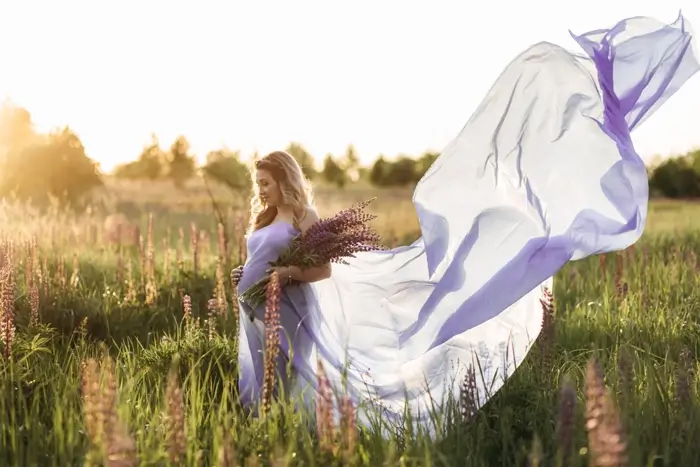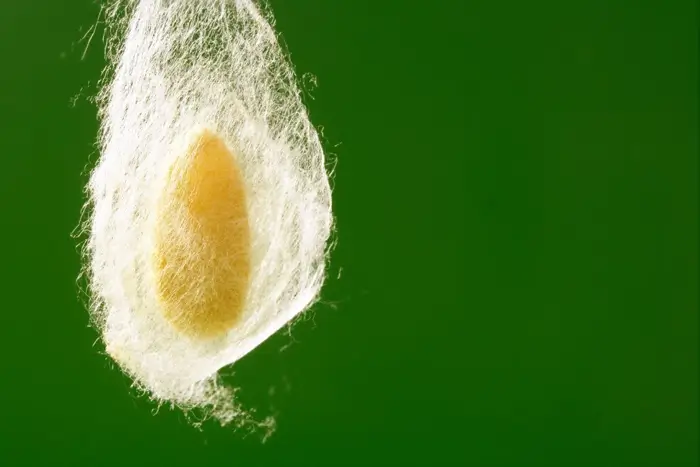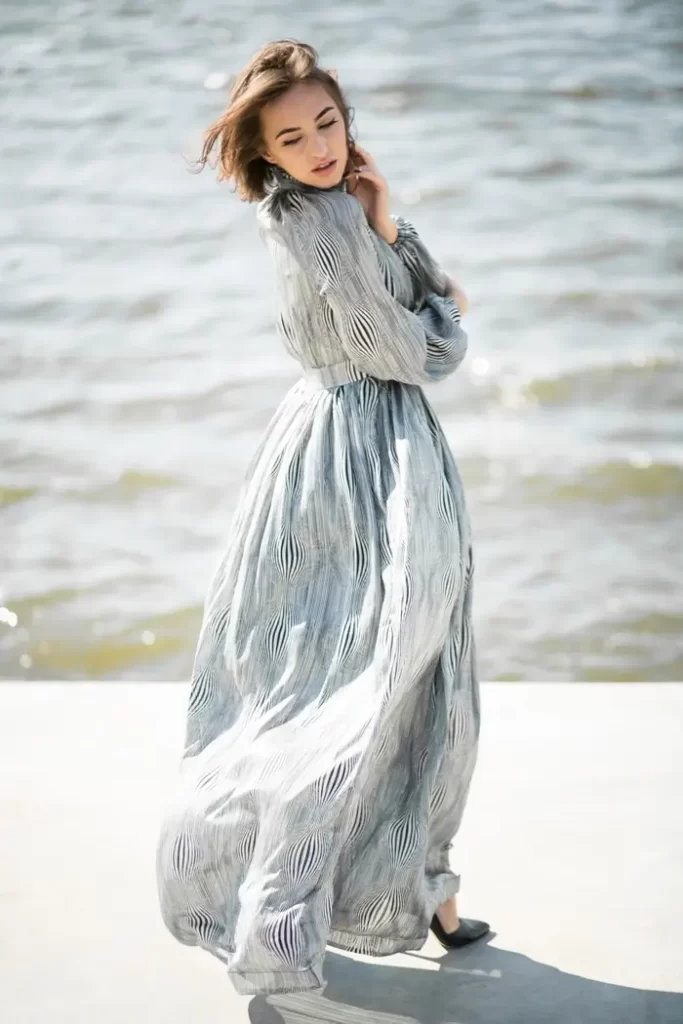Selecting the perfect fabric for your dress is a crucial step in creating a garment that not only looks stunning but also feels comfortable to wear. The type of fabric that you choose can significantly influence the overall style, drape, and even the durability of your dress.
Remember, the perfect fabric for your dress will depend on your personal preferences, the style you want to achieve, and the occasion for which you’re creating the dress. By considering these factors and exploring huge range of different fabric options, you’ll be well on your way to discovering the perfect fabric for your dress. Happy sewing!
UNDERSTANDING FIBER TYPES

Understanding different fiber types is essential when selecting fabrics for sewing dresses. Each fiber type has unique characteristics that affect the dressmaking fabric’s feel, appearance, and performance. Here are some common fiber types used in dressmaking:
Natural Fibers

- Cotton
Cotton is a soft and breathable natural fiber. It is widely used for its comfort and versatility, suitable for both casual and formal dresses. Cotton fabric can be lightweight or medium-weight, depending on the weave.
- Silk
Silk is a luxurious and lustrous natural fiber known for its smooth feel and elegant drapey fabrics. It is commonly used in formal and evening dresses, imparting a touch of sophistication.
- Linen
Linen is a lightweight and breathable natural fiber made from the flax plant. It has a textured look and offers excellent breathability, making it suitable for summer dresses.

Animal-based Fibers
- Wool
Wool fabric is a warm and durable fiber obtained from sheep or other animals like cashmere or angora. It is commonly used for winter dresses and provides insulation.
- Silk (from silkworms)
Silkworms produce silk fibers that are used to create luxurious and delicate fabric. Silk dresses are often associated with elegance and refinement.

Synthetic Fibers
- Polyester
Polyester is a synthetic fabric known for its durability, wrinkle resistance, and ease of care. It can mimic the appearance of natural fibers and is commonly used for various dress styles.

- Nylon
Nylon is a strong and lightweight synthetic fiber with excellent elasticity. It is often twisted yarn blended with other synthetic fibers, to enhance durability and stretch.
- Rayon
Rayon is a semi-synthetic fiber made from wood pulp. It has a soft feel and drapes well. Rayon can be found in different variations such as viscose rayon, modal, or lyocell, each with its own characteristics.
Blended Fibers

- Blended fibers combine two or more types of fibers to create fabrics that incorporate the desirable qualities of each. Common blends include cotton/polyester, cotton/linen, or wool/silk. Blends can offer enhanced durability, wrinkle resistance, or improved drape.
Each fiber type has its own set of advantages and considerations. Factors such as comfort, breathability, durability, drape, and desired aesthetic should be considered when choosing a fabric for a dress. Additionally, it’s important to consider care instructions and the specific requirements of each fiber type to ensure the longevity of the dress.
WHAT MAKES A FABRIC PERFECT FOR SEWING A DRESS?

Several factors contribute to making a fabric perfect for sewing a dress. Here are some key characteristics to consider when choosing a fabric for dressmaking:
Drapability
The fabric should have a good drape, meaning it falls and hangs nicely when used in garments. Fabrics with excellent drape create a flattering silhouette and flow beautifully on the body.
Comfort and Wearability
Consider how the dressmaking fabric feels against the skin. It should be comfortable to wear, allowing ease of movement without being restrictive. Fabrics that are soft, breathable, and lightweight are often preferred for dressmaking.
Stability and Structure
Depending on the dress style, you might want a fabric that offers stability and structure. Structured dresses, such as those with fitted bodices or full skirts, require fabrics that can hold their shape. Fabrics with a bit of stiffness, like taffeta or brocade, work well for structured designs.
Durability
A dress is typically meant to be worn multiple times, so choosing a fabric that is durable and long-lasting is important. Look for fabrics that can withstand regular wear, washing, and potentially some stretching or pulling.
Versatility
Consider whether the fabric is versatile enough to suit different dress styles. Some fabrics lend themselves better to formal or evening wear, while others work well for more casual dresses or everyday dresses. If you plan to use the same fabric to make dresses for multiple projects, versatility becomes even more critical.
Maintenance
Take into account the fabric’s care requirements. Consider your willingness to follow the fabric’s specific care instructions, such as dry cleaning or delicate washing. Opt for fabrics that align with your preferred maintenance routine.
Color and Print
The fabric’s color and print play a significant role in the overall aesthetic of the dress. Choose colors and prints that align with your style, the occasion, and your personal preferences. Consider how the fabric color complements your skin tone and whether the print suits the dress design.
Budget
Finally, consider your budget when selecting fabric for your dress. Fabrics come in a wide range of prices, so it’s essential to find a balance between the fabric’s quality and your budget constraints.
Remember, the “perfect” fabric may vary depending on the specific dress design, the occasion, and your personal preferences. It’s always beneficial to explore different fabric options, request swatches, and consider how each fabric aligns with the characteristics mentioned above.
Which Fabric is Best for Summer Flowy Dresses?

When it comes to summer flowy dresses, lightweight and breathable fabrics are the best choices to keep you cool and comfortable. Here are some fabrics that work well for summer flowy dresses:
Cotton
Cotton is a popular choice for summer dresses due to its excellent breathability and comfort. It absorbs moisture and allows air circulation, keeping you cool on hot days.
Linen
Linen is a natural fabric made from flax fibers. It has a lightweight and breathable quality, making it ideal for summer garments. Linen has a relaxed and slightly textured look, giving flowy dresses a casual and effortless vibe.
Rayon
Rayon, especially in its lightweight variations like viscose or modal, is another suitable choice for summer flowy dresses. It has a soft and smooth texture, drapes beautifully, and offers good breathability.
Chiffon
Chiffon is a sheer and lightweight fabric known for its delicate and ethereal look. It has a flowing drape and is often used in summer dresses, especially for special occasions or feminine designs.
Georgette
Georgette is a lightweight, sheer fabric that is slightly more textured than chiffon. It has a soft drape and is often used for flowy summer dresses due to its light and breezy feel.
Silk
Silk is a luxurious and breathable fabric that feels cool against the skin. It has a beautiful drape and adds an elegant touch to flowy summer dresses. Look for lightweight silk fabric variations like crepe silk or silk chiffon.
Modal
Modal is a type of rayon made from beech tree fibers. It is known for its softness, breathability, and excellent drape. Modal fabric is a great option for summer flowy dresses that require a comfortable and flowing silhouette.
Voile
Voile is a lightweight and semi-sheer fabric with a soft and airy feel. It has a slightly crisp texture and is a woven fabric often used for summer dresses that require a delicate and romantic look.
These fabrics offer the desired breathability, lightweight feel, and drapability needed for comfortable and flowy summer dresses. Consider the specific design and style of your summer dress when choosing the fabric to ensure it achieves the desired aesthetic and comfort in warm weather.
FABRIC WEIGHTS FOR SEWING DRESSES

When sewing dresses, the weight of the fabric plays a crucial role in the overall look, drape, and suitability for different styles. Here are some common fabric weights and types used for sewing dresses:
Lightweight Fabrics
Lightweight fabrics are ideal for creating flowy and delicate dresses. They provide an airy and ethereal look, perfect for summer or special occasion dresses. Examples include:
- Chiffon: A sheer, lightweight fabric with a delicate drape.
- Georgette: A lightweight, semi-sheer fabric with a slightly crinkled texture.
- Organza: A crisp, sheer fabric that adds structure and volume to dresses.
- Voile: A lightweight, semi-sheer fabric that is soft and breathable.
Medium-weight Fabric
Medium-weight fabrics are versatile fabric and suitable for a wide range of dress styles. They offer a balance between structure and drape, making them popular choices for both casual and formal dresses. Examples of knit fabrics include:
- Cotton: A medium-weight cotton fabric that is breathable and comfortable.
- Linen: A medium-weight fabric with a slightly textured look and excellent breathability.
- Rayon: A lightweight to medium-weight fabric that drapes beautifully and is available in various finishes like viscose or modal.
- Crepe: A fabric with a subtle texture and good drape, such as crepe de chine or crepe georgette.
Heavyweight Fabrics
Heavyweight fabrics are used for more structured or winter dresses, where durability and warmth are desired. They offer more stability and can provide volume and shape to the dress. Examples of heavy weight fabric include:
- Wool: A warm and sturdy fabric that is often used for winter dresses.
- Velvet: A luxurious, heavyweight fabric with a soft pile and a rich appearance.
- Brocade: A thick and textured fabric often used for formal or special occasion dresses.
- Tweed: A medium to heavyweight fabric with a woven texture, commonly used for tailored or winter dresses.
It’s important to note that fabric weight is not the sole determinant of the dress’s suitability. Other factors such as the dress style, design, and desired look should also be considered. It’s always a good idea to consult patterns, fashion references, or experienced sewers to determine the recommended fabric weight for a specific dress design. Additionally, experimenting with fabric samples and draping techniques can help you visualize the final result before committing to a particular fabric weight.
CHOOSING THE RIGHT FABRIC FOR YOUR DRESS

Choosing the right fabric for your dress involves considering several factors to ensure the fabric complements your design, style, and comfort. Here’s a step-by-step guide to help you select the perfect fabric for your dress:
Determine the Dress Style
Consider the style and purpose of the dress. Is it a casual sundress, an elegant evening wear or wedding gowns, or a structured formal dress? The fabric should align with the intended style and occasion.
Consider the Season and Climate
Take into account the season in which you’ll be wearing the dress. Lightweight and breathable fabrics like cotton or linen are ideal for summer, while heavier fabrics like wool or velvet suit colder months.
Assess the Drape
Think about how you want the dress to drape on your body. For flowy and ethereal designs, choose fabrics with a soft and fluid drape, such as chiffon or silk. For more structured styles, opt for fabrics with a bit of stiffness like taffeta or brocade.
Consider Comfort
Evaluate the comfort factor of the fabric. Look for materials that feel comfortable against your skin and allow for ease of movement. Fabrics like cotton, silk, or modal are often preferred for their breathability and softness.
Evaluate Durability
Assess the durability of the fabric, particularly if you plan to wear the dress multiple times. Consider whether the fabric can withstand regular wear, washing, and potential stretching or pulling.
Review Maintenance Requirements
Take into account the care instructions for the fabric. Consider your willingness to follow specific care requirements, such as dry cleaning or delicate washing. Choose a fabric that aligns with your preferred maintenance routine.
Explore Colors and Prints
Consider the color palette and prints that align with your personal style, the occasion, and your skin tone. Select colors and prints that complement the design and enhance the overall aesthetic of the dress.
Set a Budget
Consider your budget when selecting the fabric. Fabrics come in various price ranges, so finding a balance between quality and cost is important.
Request Swatches and Test
If possible, order fabric swatches or visit a fabric store to physically examine and touch the fabrics you are considering. This allows you to assess the texture, weight, and overall feel of the fabric before making a final decision.
By considering these factors, you can narrow down your options and choose a fabric that not only suits your dress design but also aligns with your comfort, style preferences, and practical considerations.
TOP 10 FABRICS FOR SEWING DRESSES

COTTON FABRICS
Cotton is a versatile and breathable fabric suitable for a wide range of dress styles. It comes in various weights and weaves, from lightweight cotton voile to medium-weight poplin, making it ideal for both casual and formal dresses. We also have cotton twill weave for sturdiness
SILK
Silk is a luxurious and lustrous fabric known for its smooth feel and elegant drapey dresses. Silky fabric adds a touch of sophistication to any dress design and is commonly used in formal and eveningwear.
LINEN
Linen is a breathable and lightweight fabric made from flax fibers. It has a slightly textured look and excellent breathability, making it perfect for summer dresses or casual-chic styles.
CHIFFON
Chiffon is a lightweight, sheer fabric with a delicate drape. It is a versatile and luxurious fabric, often used for creating flowy and ethereal dresses, especially for special occasions or romantic designs.
CREPE
Crepe fabric has a slightly textured surface and good draping properties. It can be made from various fibers, including silk, various polyester blends, or rayon, and is suitable for both casual and formal dresses.
JERSEY
Jersey is a knit fabric known for its stretch and comfort. It is commonly used for creating comfortable and fitted dresses, such as bodycon or wrap styles. Silk jersey and cotton jersey are some know types of jersey fabric.
VELVET
Velvet is a luxurious and plush fabric with a soft pile. It adds richness and texture to dresses, making it a popular choice for formal or other evening wear and attire.
SATIN
Satin fabric is a smooth and shiny fabric with a lustrous appearance. It is commonly used for creating glamorous and elegant dresses, particularly for special occasions.
TAFFETA
Taffeta is a crisp and slightly stiff fabric with a subtle sheen. It is often used for structured or formal dresses, creating volume and shape.
RAYON
Rayon is a versatile and lightweight synthetic fabric made from cellulose fibers. It can mimic the qualities of natural fibers like silk or other cotton blends, and is available in various finishes, such as viscose or modal. Rayon is suitable for a wide range of dress styles.
How to Choose the Best Fabric for Your Dress Project (Step-by-Step Process)

When choosing types of fabric for dresses, there are several important factors to consider. Here’s a comprehensive list of the different fabrics and what to keep in mind:
Dress Style and Purpose
Consider the style and purpose of the dress. Is it for a casual occasion, a formal event, or everyday wear? The fabric choice should align with the intended style and the dress’s overall purpose.
Season and Climate
Take into account the season and climate in which the dress will be worn. Choose fabrics that provide the appropriate level of warmth or breathability. Lighter and more breathable fabrics are suitable for summer, while heavier and warmer fabrics are better for colder seasons.
Comfort and Feel
Consider the comfort and feel of the fabric against the skin. Fabrics like cotton, silk, or modal are known for their softness and comfort. Consider the sensitivity of the wearer’s skin and choose fabrics accordingly.
Drapability and Structure
Think about the desired drape and structure of the dress. Some fabrics have a fluid and flowy drape, while others offer more structure and stiffness. The drape of the fabric should complement the desired silhouette and design of the dress.
Durability and Longevity
Assess the durability and longevity of the fabric. Consider factors such as the fabric’s weave, strength, and resistance to wear and tear. Choose fabrics that can withstand regular use and washing, especially if the dress will be worn frequently.
Care and Maintenance
Review the care instructions for the fabric. Some fabrics require specific care, such as dry cleaning, handwashing, or ironing at low temperatures. Consider your willingness and ability to maintain the fabric according to its care requirements.
Color and Print
Explore different colors and floral prints that align with your design vision. Consider the color palette, patterns, or prints that complement the dress style and wearer’s preferences. Take into account the potential for color fading or print distortion over time.
Fabric Width and Yardage
Check the width of the fabric and calculate the required yardage for your dress project. The width will determine how much fabric you need and whether you can achieve the desired dress design within the available width.
Budget
Set a budget for your fabric purchase. Fabrics can vary significantly in price, so consider your budget and find a balance between quality and affordability. Remember to account for the required yardage and any additional materials needed for the dress project.
Sourcing and Availability
Consider the availability and sourcing of the fabric. Some fabrics may be readily available at local fabric stores, while others may require ordering online or from specialty suppliers. Plan ahead to ensure you can obtain the desired type of fabric in a timely manner.
By considering these factors, you can make an informed decision when choosing the types of fabric for your dresses. It’s important to find a fabric that not only suits the dress style and wearer’s comfort but also aligns with the desired aesthetics and practical considerations.



